©
2004 Jeff Matthews & napoli.com
Art
theft—
 Art
theft is a major problem in much of Italy, and Naples is no exception.
Paintings and statues of varying degrees of worth disappear all the
time from small, unguarded churches, and pilferage is of great concern
even at major archaeological sites such as Pompeii and Herculaneum,
which are relatively well guarded. (I recall, however, a friend familiar
with Mexican archaeology telling me once as we walked around Herculaneum
how incredible it was to him that you could actually walk right into
the buildings and touch everything. "They wouldn't let you near anything
this valuable in Mexico.") There's no telling where much of the
stuff winds up—probably in the hands of private collectors elsewhere
in the world. Sometimes the authorities get the material back, sometimes
they don't. Art
theft is a major problem in much of Italy, and Naples is no exception.
Paintings and statues of varying degrees of worth disappear all the
time from small, unguarded churches, and pilferage is of great concern
even at major archaeological sites such as Pompeii and Herculaneum,
which are relatively well guarded. (I recall, however, a friend familiar
with Mexican archaeology telling me once as we walked around Herculaneum
how incredible it was to him that you could actually walk right into
the buildings and touch everything. "They wouldn't let you near anything
this valuable in Mexico.") There's no telling where much of the
stuff winds up—probably in the hands of private collectors elsewhere
in the world. Sometimes the authorities get the material back, sometimes
they don't.
This morning's
paper carried a story of what counts as a major "bust" in Naples. They
have arrested a gentleman who had 21,000 objects of artistic or archaeological
interest in his home in Campi Flegrei (the
Flegrean Fields) outside the city. The gentleman in question has been
very busy over the last few years scouring the area known as "Magna Grecia" —ancient Greek colonies on
the southern Italian mainland. His collection—obviously meant
for illicit sale to collectors elsewhere—ranges from the Bronze
Age to the Middle Ages and includes pottery, bronze items, and even
fossils.
Sometimes,
you can be sitting on top of something of interest. In many of those
cases it is best to let things lie and not say anything—at least,
that is the opinion of those average citizens sitting on top of it.
Because of the long and tortured history of the subsoil of Naples, most
of the streets in the old historic Greco-Roman
center of the city—although they lie accurately over the street
grid of the old city—are, in some cases, as much as 40 feet above
the ancient streets themselves. In the case of the actual, geographic
center of the old city—the intersection of via dei Tribunali and
via San Gregorio Armeno, where the modern churches of San Lorenzo and
San Paolo Maggiore now stand—that area was buried by a massive
mudslide in the sixth century. The excavated site of the Roman market
place below San Lorenzo is the only major excavation in the old city.
Thus, all
of the buildings within a few squares blocks of that site have basements
that would count as museums anywhere else in the world. Bits and pieces
of ancient Greece and Rome are simply sticking out of the walls if you
go down below the ground floors of any building in the area. Should
the shopkeeper call the museum to come and get this piece of mosaic
or that tile or vase? Maybe not. They might close down the shop and
declare the poor man's business a national treasure. Even worse: they
might form a committee to decide what to do.
Aboveground
ruins are another sticking point. There is a large remnant of a Roman
amphitheater on the western hillside of Cape Posillipo. It is near
the exit of an old Roman tunnel beneath that hill. The amphitheater
is, however, on private property and may be visited only by appointment
through various cultural or tourist organizations --two or three times
a year. The owner's point of view is that if everyone in Naples opened
their property to archaeological "culture vultures," then there would
be no private property in Naples. Everything, it seems, is on
top of something interesting.
Christmas
(3)--Tu scendi dalle stelle,
music (2),
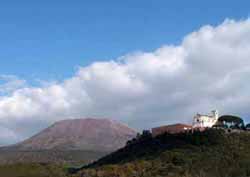 I
haven't seen or heard the traditional Neapolitan Christmas musicians
much this year, but then I have been avoiding the crowded areas of town
where they are most likely to appear. They are buskers—street
musicians—and there are always two of them, dressed as shepherds;
one plays the Neapolitan bagpipe, called the zampogna and the
other plays the ciaramella, a kind of folk oboe. I
haven't seen or heard the traditional Neapolitan Christmas musicians
much this year, but then I have been avoiding the crowded areas of town
where they are most likely to appear. They are buskers—street
musicians—and there are always two of them, dressed as shepherds;
one plays the Neapolitan bagpipe, called the zampogna and the
other plays the ciaramella, a kind of folk oboe.
It seems
to me that they always play the same thing: a melancholy, minor carol
called, in the original Neapolitan, Quanno Nascette Ninno, said
to be by Alfonso Maria de’ Liguori (1696-1787) a famous Neapolitan
cleric and founder of the Catholic order known as The Redemptorists,
or the Congregation of the Most Holy Redeemer. The order still resides
in a strikingly picturesque monastery on a knoll on the slopes of Vesuvius
(photo). The church there is named for the founder, proclaimed St. Alfonso
in 1839. That carol is the basis for the best known Italian carol, Tu
Scendi dalle Stelle, except that the newer, Italian version is in
a major key. The Italian words are apparently by Pope Pius IX (1846-1878).
If known to an English-language audience at all, Tu Scendi dalle
Stelle is known as From Starry Skies Descending. It still
sounds to me as if the only thing the Pope did was happy up the original
a bit by putting it in a major key. In an unrelated (I think) episode,
this is the same Pope who proclained de' Liguori Doctor of the Church
in 1871.
Italian
translations of carols from other languages abound, but there is not
the strong English and German tradition of the carol, nor is there anything
like the mid-20th-century American secular Christmas song, ones such
as Silver Bells, Have Yourself a Merry Little Christmas,
I’ll Be Home for Christmas, and White Christmas.
In any event, in a crowded bookshop this morning —while jousting
for one of the few remaining copies of a book my wife wants for Christmas—I
was treated to a horrible version of Oh, Holy Night, being pop-sung
through the in-house audio system by some American singer whose name
I do not know.
De Filippo,
Eduardo (1900-84) (2); Natale
in Casa Cupiello
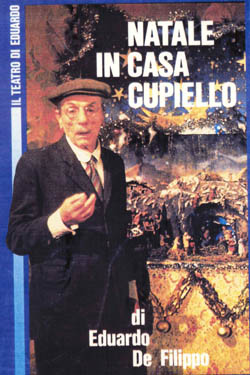 In
the select group of artists whom Italians refer to by first name only
(Dante, Leonardo, Michelangelo) belongs the great Neapolitan actor and
playwright Eduardo de Filippo (1900-1984).
Eduardo wrote in Neapolitan dialect,
which makes his works less accessible than they merit, but also
gave him the advantage of a rich, authentic voice to portray his favorite
subjects, the real Neapolitans of the "quartieri" ever engaged
in a mundane war of attrition to survive, all the more ferocious for
its regularity. In
the select group of artists whom Italians refer to by first name only
(Dante, Leonardo, Michelangelo) belongs the great Neapolitan actor and
playwright Eduardo de Filippo (1900-1984).
Eduardo wrote in Neapolitan dialect,
which makes his works less accessible than they merit, but also
gave him the advantage of a rich, authentic voice to portray his favorite
subjects, the real Neapolitans of the "quartieri" ever engaged
in a mundane war of attrition to survive, all the more ferocious for
its regularity.
In 1931
Eduardo turned his talents to describing a few days in the life of the
Cupiello family, set against the most venerable Neapolitan symbol of
Christmas, the Presepe, the home-made table-top rendering of
the Holy Family in the Manger. The three-act play Natale in Casa
Cupiello (Christmas at the Cupiello's) is the the story of
the determination of one man, Luca Cupiello, the father of the
family, to build his Presepe. In the relatively short time since
it was first staged, Casa Cupiello has become the traditional Christmas
favorite among Neapolitans.
First,
there is the fact—crucial to understanding the inhabitants of
Naples—that there is no let-up in the daily grind, even at Christmas.
The family Cupiello is beleaguered by squabbles, petty theft within
the family, a married daughter running off with her lover, a mooching
brother-in-law and a layabout bum of a son, none of whom can understand
how an adult would still want to fool with something as childish as
a Presepe, and all of whom conspire to sidetrack Luca from this
symbolic reenactment of the Nativity. Yet while the Cupiello family
threatens to unravel right before our eyes, Luca builds his Presepe
with the single-mindedness and faith implicit in Christ's
admonition to "be as simple children…to enter the Kingdom of Heaven."
Eduardo's
specialty is blending the tragic and comic. Donna Concetta, Luca's long-suffering
wife, is seated alone at the living room table, desperate and alone
in her knowledge that their daughter is about to leave her husband;
at that moment the door from the kitchen opens and in come her husband,
son and brother-in-law bearing their Christmas gifts to her. A few moments
earlier they had been bickering and yammering like the Three Stooges
over who was going to give her what gift; now they are The Three Wise
Men, appearing suddenly and sublimely, surrounding Concetta and leaving
her surrealistically suspended between tears and laughter and refocusing
our attention on the things that really matter.
And just
as "Merry Christmas"/ "Bah-Humbug" runs through Dickens' A Christmas
Carol until Scrooge is finally redeemed into wishing
everyone a Merry Christmas, in Casa Cupiello there is a similar
call and response between the father and his son, Nennillo:
Father:
"Do you like the Presepe".
Son: "No!"
At one
point, Luca is frisking Nennillo's pockets for five missing lire. (Early
on, it has been established that Nennillo, a spoiled brat, is light-fingered
even to the point of filching and selling his uncle's shoes.) Luca finds
the money but tries to blackmail his son into saying he likes the Presepe,
after all. "No!" insists Nennillo, at which point Luca holds up the
money for the entire family to see. As it turns out, Nennillo had, indeed,
pilfered the money from his uncle—who had stolen it from Luca
in the first place!
It is the
son's "no" that has to be changed, redeemed by play's end. Luca has
finally built his Presepe, but has suffered a stroke and is obviously
dying. His last question to his son is the same: "Do you like the Presepe?"
His son, moved by his father's passion and by his own compassion,
the most Christian of all qualities, says "yes" to his father and to
the Presepe at the same time.
Eduardo's
stage directions have Luca hearing the whispered "Yes" and then
looking slowly off into the distance where he imagines a Presepe as
great as the world itself, with real people rushing to the side
of the real Christ Child. Lost in his vision, he utters the final words
of the play:
"What
a beautiful Presepe. How beautiful!"
The Neapolitan
Presepe (1)
This
terracotta Navity scene is part of the display in
the Bavarian National Museum in Munich, Germany. It
was crafted by Giuseppe Sanmartino, the same artist
who sculpted the Veiled Christ in
the Sansevero
Chapel in Naples.
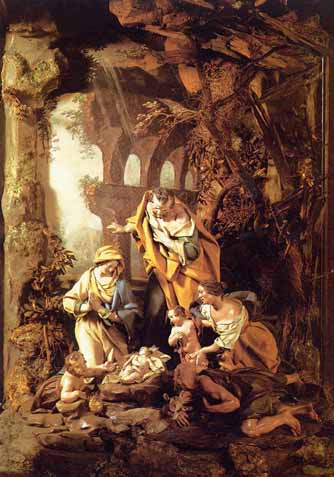 The
Nativity scene, or Christmas Crib, (Presepe, in Italian) on permanent
display at the museum of San Martino
in Naples has been recently restored and is the finest example in the
world of how the building of these tableaus had developed to a craft
and an art by the 18th century in Naples. The
Nativity scene, or Christmas Crib, (Presepe, in Italian) on permanent
display at the museum of San Martino
in Naples has been recently restored and is the finest example in the
world of how the building of these tableaus had developed to a craft
and an art by the 18th century in Naples.
Unlike
the Cross, which to Christians stands for redemption and salvation,
or even the evergreen tree, which by its very nature symbolizes that
which is unchanging, the presepe really isn't a symbol—it
"means" exactly what you see: the birth of Christ. It fulfills a deeply
felt need even from the earliest times to tell and hear stories of the
Holy Family, to recreate each year anew the eternal message of Christmas.
Popular
Christian tradition says that St. Francis of Assisi started the
custom of remembering Christmas through a tableau of Mary, Joseph and
others around the manger crib of Jesus in the stable at Bethlehem, but
the tradition is certainly much older than that. Pilgrims to the grotto
chapel of Bethlehem in the early centuries of Christianity spoke of
decorative representations depicting the first Christmas, and as early
as the seventh century, relics said to have been part of the manger
in Bethlehem were transferred to Rome to the Domus Sancta Dei
Genetricis—the House of the Holy Mother of God . The Domus
came to be known as the Praesepe (crib) and in modern
Italian is presepe or presepio . Long before St.
Francis there were elaborate Latin Liturgical dramas with actors, dialogue
and music. These productions were so theatrical that Pope Innocent III
denounced them in 1207 on the grounds that they threatened the sanctity
of ancient traditions.
This is
where St. Francis comes in. He got permission from Innocent to set up
a presepe in 1223 in the town of Greccio in order to celebrate Christmas
in his own way —simply. Thomas of Celano, a biographer of St.
Francis tells how "Greccio was transformed into a second Bethlehem,
and that wonderful night seemed like the fullest day to both man and
beast for the joy they felt at the renewing of the mystery." There was
no music, no liturgical drama—just the Crib, and Francis preaching
and restoring simplicity and tenderness to the tale of the birth of
the Saviour.
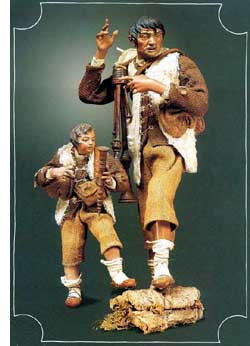 During the Renaissance, religious plays
returned, but they were no longer Latin Liturgical dramas. They were
now transformed by local customs and language; once again—almost
as if to reject the simplicity of the Miracle— the manger was
incorporated into elaborate Nativity Plays with stage managers,
sets designed by prominent artists, ever greater numbers of actors and
increasingly ambitious plots involving fire-belching devils and legions
of angels and shepherds. All this was staged, of course, in church.
Productions of this nature were clearly out of place, not the least
reason for which was that various incendiary special effects actually
burned down a number of churches. Again the plays disappeared—this
time for good. But the tradition of the Christmas Crib, itself, from
that time to this, has remained. During the Renaissance, religious plays
returned, but they were no longer Latin Liturgical dramas. They were
now transformed by local customs and language; once again—almost
as if to reject the simplicity of the Miracle— the manger was
incorporated into elaborate Nativity Plays with stage managers,
sets designed by prominent artists, ever greater numbers of actors and
increasingly ambitious plots involving fire-belching devils and legions
of angels and shepherds. All this was staged, of course, in church.
Productions of this nature were clearly out of place, not the least
reason for which was that various incendiary special effects actually
burned down a number of churches. Again the plays disappeared—this
time for good. But the tradition of the Christmas Crib, itself, from
that time to this, has remained.
There are
as many different kinds of Cribs as there are places where Christmas
is celebrated. Some of them use life-size figures and some even real
animals and people to recreate the stable in Bethlehem; in some areas,
shepherds bring gifts of cloth from Flanders or grapes from Burgundy;
in Tuscany the shepherds and their dogs have names and they bring wood
and cheeses and chestnuts; there are mechanical clockwork cribs from
Dresden and ones that school children craft from simple cardboard and
paper-maché; there are Chinese cribs and ones sculpted
elegantly out of ebony in the Congo; they have been modeled in rustic
clay and elegant porcelain; they have been ornate tableaus in Baroque
churches and simple two-dimensional cut-outs propped up on suburban
lawns.
The tradition
of the presepe in Naples is special. By the eighteenth century the city
is said to have had 400 such displays in its churches and many
more in private homes, as well. The King supervised the building of
his own presepe and the whole court was kept busy in the days leading
up to Christmas. (Tradition requires that the scene be built up over
time, little by little, until on Christmas Eve, the Christ Child is
put in the manger as the very last element of the display.) Even the
royal presepe, however, could not have compared to the one to be seen
at the museum of San Martino. The thousands of figures in the main presepe
and secondary display cases are all original, having been gathered from
those made by "figurari," craftsmen of that period who specialized in
such Nativity scenes. They introduced the use of bodies of cloth wound
on wire, with feet, hands and head exquisitely modeled and painted.
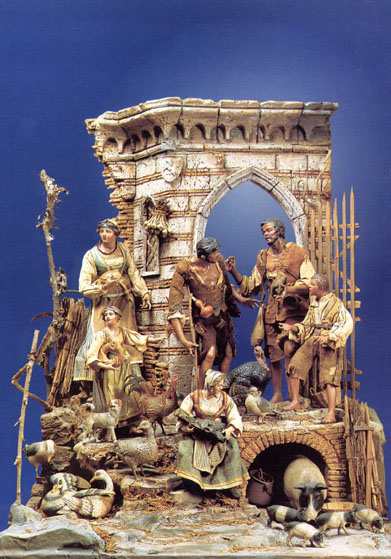 The Manger, itself, is at the
center and is overarched by a host of angels suspended from the ceiling.
The three Wise Men, accompanied by an incredible entourage, have proceeded
to the site of the Birth through a typically local countryside, one
peopled by shepherds and musicians, salesmen displaying their goods,
minstrels playing and guests eating and drinking at an inn where every
variety of macaroni and fish, meat, sausages, fruits and wines from
the Neapolitan countryside are on display. There is exquisite detail
on all the faces of all the figures; the construction of even the tiny
musical instruments is accurate; and even the faces of the animals are
painstakingly curious or grave or sleepy. The Manger, itself, is at the
center and is overarched by a host of angels suspended from the ceiling.
The three Wise Men, accompanied by an incredible entourage, have proceeded
to the site of the Birth through a typically local countryside, one
peopled by shepherds and musicians, salesmen displaying their goods,
minstrels playing and guests eating and drinking at an inn where every
variety of macaroni and fish, meat, sausages, fruits and wines from
the Neapolitan countryside are on display. There is exquisite detail
on all the faces of all the figures; the construction of even the tiny
musical instruments is accurate; and even the faces of the animals are
painstakingly curious or grave or sleepy.
Away from
the museum, a walk along many of the side streets in Naples in December,
particularly via San Gregorio Armenio in
the historic center of town [also
see the map of the Historic Center], will show you that in spite
of the increasing presence of northern customs such as Christmas
Trees and Santa Claus, the tradition of the presepe is still very much
alive. Shops set out their countless figures and models
of the Holy Family, shepherds, musicians, Wise Men, angels, oxen and
all the others. These days, of course, you will also find figures that
are new and mass-produced, but the older second-hand figures are special.
At one time or another they were all in someone else's presepe just
as they are now in yours.Thus do they continue their passage through
this long tradition, and thus do Neapolitans continue their popular
elaboration on the original, their affirmation of the universality
of Christmas—a way to "renew the mystery", to be present in Bethlehem.
Marotta,
Giuseppe (1), Fruit of Christmas, The
 While
the birth of Christ means much the same to Christians all over the world,
the faithful everywhere blend Christmas with their own peculiar characteristics.
To see what this means in Naples, one has to go beyond the traditional
nativity tableau, the presepe; and beyond the benevolent
old crone, the befana, who brings gifts on the eve of the twelfth
day of Christmas; and beyond the plaintive wailing of the traditional
Neapolitan Christmas musical instruments, the zampogna (bagpipe)
and ciaramella (folk oboe). While
the birth of Christ means much the same to Christians all over the world,
the faithful everywhere blend Christmas with their own peculiar characteristics.
To see what this means in Naples, one has to go beyond the traditional
nativity tableau, the presepe; and beyond the benevolent
old crone, the befana, who brings gifts on the eve of the twelfth
day of Christmas; and beyond the plaintive wailing of the traditional
Neapolitan Christmas musical instruments, the zampogna (bagpipe)
and ciaramella (folk oboe).
Music,
however, may give us a clue as to just what we are looking for. Much
Neapolitan folk music shifts strangely between major and minor, thus
lending to a single melody both joy and melancholy. It is as if the
music, itself, had mixed emotions about life. A number of Neapolitan
authors have written about this tragic-comic ambivalence, this
sorrow in the midst of joy, and they express it most poignantly when
they write about Christmas.
The play
Natale in Casa Cupiello (Christmas at the Cupiello's, see
above) by the great Neapolitan playwright, Eduardo de Filippo is about a man obsessed with building
his presepe. As one silly and outrageous domestic crisis after
another whirls on around him, it is his symbolic reenactment of the
Nativity that refocuses the love which inheres in his family on the
values that matter. He dies at the end, but his presepe has done
what it was supposed to, and his last vision in this life is that of
the entire world as a gigantic nativity scene, a stage for universal
love.
There is
another tale, similarly touching, and typically Neapolitan in its rendering
of the light-hearted and the mournful at the same time. It is called,
simply, La Mostra (The Display). It is one of an exquisite collection
of tales about Naples by Giuseppe Marotta, called L'Oro di Napoli
(The Gold of Naples) in which the precious metal is a metaphor of those
moments that give value to all of our lives, but, perhaps, particularly
to the lives of the troubled. [The quoted material, below, is my translation.]
"Christmas
in Naples," says the author, "is the longest holiday of the year."
The nights before Christmas, he says, start in late November…
"…with
the first shutters banging in the wind, and beneath the moist moon of
the warm night breezes there suddenly slips in that cold glass-like
chill, stripping clean the stars and mountains… The true clear
air, kept young by the wind at God's bidding, the empty spaces between
the stars spreading wide to receive the prayers from the streets below
or to permit the passage of the comet of Annunciation… and the
braciere , that tiny coal-fired brass fireplace with a smooth
soft rim to rest your feet on, full of glowing embers to make you pensive."
La
Mostra is about the fruit vendor Aniello Scala and his wife
Concetta. Aniello is a gaunt man, frail and sick from the consumption
that has beset him for years. Once, he was actually dying, but just
as the last rites were to be administered he suddenly sat up, "declared
that he was in no hurry and asked for a plate of stringbeans and tomato"!
He then married young Concetta and from that time to this he has been
obsessed with his yearly ritual of building a magnificent display of
Christmas fruit!
"…the
explosive red apples… the blonde figs streaked with white, sensuous
and ripe …the display knew no limits, it just poured out of the
shop and kept going, winding up wherever it wound up. It was like an
amphitheater with its rows of figs, pomegranates, oranges, its
podium of melon, prickly pear cactus and pineapple, the imperial tribune
of tangerines, berries and apples. Or perhaps it was a temple, a great
altar of medlar and pear, the naves of chestnut and columns of fig and
grape, unto which sacred offerings of dates and bananas are brought.…
Day after day he would unload baskets in his shop, then work on the
essential nucleus of the display, the tentacles of which would eventually
branch out and meander over the threshold and out into the alleyway…"
He is as
obsessive about it as Cupiello is about the presepe in Eduardo's story.
His fruit is full of —is—life, the new Christian
life of faith as well as the sweet freshness of life which he knows
no longer dwells within his own body, and perhaps even the life which
he is about to 'give' to—and for—his wife in a very unusual
fashion.
"It
was what he lived for and it had sustained him even in those moments
when they had lost their four children with tragic regularity…"
Here, then,
is the tragedy, in the midst of an overblown comic description of mounds
of fruit spilling out the doors: the loss of their children. Now the
tragedy spools out:
"Concetta
loved don Aniello. You couldn't put up with those tiny sounds of body
joints cracking in a sick husband in a marriage bed (and sounding like
knuckles knocking on a wooden coffin) without loving him. She loved
his irrevocable will to live; it was his most human and yet masculine
quality. She continued to love him for that until the moment the white
cart came once again and bore away their fourth child. Then she started
acting strangely: she refused to mourn, she cut out a picture of a tabby
cat and kept it under her pillow, she took off her wedding ring and
put it beneath her statue of Sant'Antonio, and grew silent…
"But
she helped him prepare the lights and the coal braciere… When
the alley was asleep, Don Aniello sent his wife to bed, lit the lamps
and chose a strategic place from which he could keep his eye on the
furthermost basket. Then he settled in to hold vigil over his creation…"
The almost
surreal weave of fruit and lost children is tied in to the final…
what… tragedy? Maybe. Maybe not.
"Don
Aniello felt the sharp cold and thought that perhaps his wife had kicked
off her covers in her sleep. Should he check? Instead, he drifted back
into thoughts of his lost children. The braciere gave off a long sweet
warmth like that of a loved one's cheek. It was made for father and
children to huddle around, to draw close and whisper. How old would
they be by now? he asked himself. Then, suddenly and without putting
his shoes back on, he got up. In the alleyway the moon was bright and
silent. As barefoot as the moon and just as ghostlike, this best of
all fruit vendors went to assure himself that donna Concetta was indeed
covered… his suspicions were confirmed: the other person, whoever
he was, saved himself by going out the window into the courtyard. Don
Aniello didn't stay long, but rested a while on the edge of the bed
gathering strength to leave."
This normally
comic Neapolitan leitmotif of the cuckold husband is sudden and totally
unexpected here, as is the compassionate treatment it receives, for
Aniello knows his wife's tragedy.
"That's
the reason you took off your wedding ring. Don't be afraid. I know what
you need and you know that I know. A child that will stay. One that
will live...
"He
went back downstairs… He was caught for a moment in the light
that shone on the impeccable banks of fruit. Here a tower of violet
apples, there a parapet of rusty apples, the same sad colour of Don
Aniello Scala's thoughts at the moment. It was a magnificent Christmas
display, one that people would talk about for a long time to come…
But one cannot ask more from one poor fragment of a lung than it can
give. Don Aniello rests his feet on the braciere. He nods and drifts
off —if that's what it is. In the magical nights before Christmas
in Naples everything is possible. The best part of Don Aniello Scala
knows where it must go and goes. His memorable display of fruit leaves
the shop and follows him."
One might
accept this tale with fatalist resignation to the fact that in the midst
of joy there must be sorrow, and in the midst of life, death—even
at Christmas. On the other hand, it takes only the slightest shift in
perspective to welcome it, as do Neapolitans, as a proclamation of the
message that in sorrow there is still joy, and in death, life—especially
at Christmas.
Zampogna
(Neapolitan
Bagpipes)
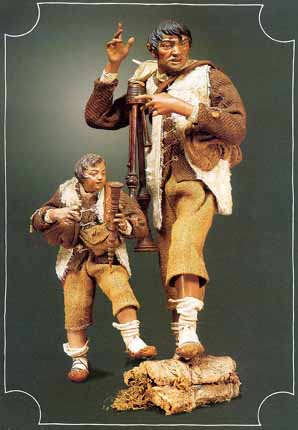 To some, its reedy and strident discords are a rallying
cry heard o'er the din of even the fiercest battle. To others, it sounds
like hell—quite literally, for according to popular legend hereabouts,
it is the instrument closest to the devil's heart, if one may at all
attribute such a goody-goody organ to the Big Bad One. It is the instrument
played at secret times and secret places during the "tregenda magica",
the Witches' Sabbath. To yet others, undoubtedly those with no ear for
tradition or the supernatural, it is the sweetest music this side of
an aerobics class for asthmatic mynah birds. To some, its reedy and strident discords are a rallying
cry heard o'er the din of even the fiercest battle. To others, it sounds
like hell—quite literally, for according to popular legend hereabouts,
it is the instrument closest to the devil's heart, if one may at all
attribute such a goody-goody organ to the Big Bad One. It is the instrument
played at secret times and secret places during the "tregenda magica",
the Witches' Sabbath. To yet others, undoubtedly those with no ear for
tradition or the supernatural, it is the sweetest music this side of
an aerobics class for asthmatic mynah birds.
"It" in
English is the bagpipe; in German, the Dudelsack, in Italian,
the cornamusa, and in Neapolitan it is called the zampogna.
Its construction has stayed basically the same over thousands of years
and in various cultures: it is characterized by an air-bladder filled
either by a bellows held under the player's arm or, more commonly, directly
by the player blowing into it. The air-bag serves as a constant reservoir
of air, avoiding any interruption of the tone by the player's having
to take a breath. The air then streams out through a main reed-pipe
called a "chanter" that has fingering holes enabling a melody to be
played, and also through at least two other secondary reed-pipes which
play single accompanying drone notes. The pipes normally have
double-reeds, giving the instrument its uniquely nasal sound.
Whatever
the sound of bagpipes may mean in other cultures, in Naples the zampogna
and its companion, the ciaramella (a double-reed oboe-like
instrument), mean Christmas. For centuries it has been the custom for
shepherds to come in from the countryside at Christmastide and wander
the streets of the city playing seasonal music, often going from house
to house and being invited in to play. Times change and over the last
few decades Christmas has been dulled by a certain commercial anesthesia,
a tinsel hype that bids us to hurry because there are only two-hundred
and twelve shopping days left. The Neapolitan version of this is that
instead of playing for the "novena", the traditional preparatory period
of nine days before Christmas, the zampogna and ciaramella seem
to show up a little earlier each year, turning the season into just
another excuse for busking. Some years they are out so early that they
look like lost druids looking for a midsummer's festival.
But, yet,
just as the songs of carolers on a snowy evening mean something to me,
the zampogna and ciaramella mean the same
thing to a Neapolitan—a beauteous mixture of home, warmth,
family and love, and, like beauty, it is very difficult to describe,
but when it happens, you know. The circumstances have to be just right:
walking alone on a crisp December evening, caught up in a moment of
childhood melancholy, when the cutting sound of the zampogna
sweeps over you like a flash of light and you see the two pastoral
figures playing music in the streets, these shepherds that Christian
tradition links so intimately to the birth of the Saviour; that one
transcendent simple instant becomes timeless and it is Christmas, for
the shepherds are standing there as if they had just stepped away from
the side of the Child for a moment to go and spread the good tidings.
Bourbons
(10), royalty (2); Savoy (2); That's
Amore
 It’s
Christmas Eve. In Naples, most people have a traditional meal very late
in the evening, often almost at midnight and running over into Christmas
Day, itself. I will go to relatives’ and eat something, I suppose,
though not what tradition requires – that is, eel. I am not going
anywhere near something that looks that much like a snake. Yes, I know
it’s a fish, but it’s a fish like a penguin is a bird –
kind of, but in an unconvincing sort of way. The eel reminds me
of a parody of the worst pseudo-Neapolitan song I know (well, it’s
the only pseudo-Neapolitan song I know): That’s Amore *.
I owe the caricature lyrics (better than the real ones) to a scuba-diver
I met once. Sung to the real melody, they start: It’s
Christmas Eve. In Naples, most people have a traditional meal very late
in the evening, often almost at midnight and running over into Christmas
Day, itself. I will go to relatives’ and eat something, I suppose,
though not what tradition requires – that is, eel. I am not going
anywhere near something that looks that much like a snake. Yes, I know
it’s a fish, but it’s a fish like a penguin is a bird –
kind of, but in an unconvincing sort of way. The eel reminds me
of a parody of the worst pseudo-Neapolitan song I know (well, it’s
the only pseudo-Neapolitan song I know): That’s Amore *.
I owe the caricature lyrics (better than the real ones) to a scuba-diver
I met once. Sung to the real melody, they start:
“What’s
that thing in the reef
with the big, shiny teeth?
That’s a Moray!
Put your hand in the crack
And you won’t get it back,
That’s a Moray!”
(So much
for today’s zoology lesson. So you were expecting Charles Darwin?)
[*For
the sake of completeness and because I am tired of people thinking that
Dean Martin composed the song, the lyrics to "That's Amore" are
by Jack Brooks (1912-71) and the music is by Harry Warren (1893-1981).
The song was composed for the film, The Caddy (Paramount, 1953)
starring Dean Martin and Jerry Lewis. That's where Dino comes in. He
sang it. Also see Neapolitan Song.]
The paper
this morning features yesterday’s meeting in the Vatican between
the Pope and the ex-royal family of Italy—Victor Emanuel of Savoy,
his wife, Marina Doria, and their son, Emanuel Filiberto. It is the
first time they have returned to Italy since the monarchy was abolished
by referendum 56 years ago. (Technically, of course, the Vatican is
a separate state, but they had to land in Rome to get there.) The constitutional
provision that forbade any member of the immediate Savoy royal family
from ever again entering Italy has been overcome, and the ex-king announced
that he would very much like to visit Naples, perhaps as early as February.
I don’t anticipate tens of thousands of peasants tossing their
pitchforks and three-cornered hats into the air and voicing “Long
live the King!” because, as far as I know, Neapolitan peasants
didn’t wear three-cornered hats, although the gentry may have
done so. When the referendum that abolished the monarchy and established
the Italian Republic was held in 1946, it is significant that, though
the nation, as a whole, was split virtually 50-50, Naples voted for
the king, 10-1. Maybe he wants to say “Thank you”.
The paper
points out that there will likely be an innocuous counter-demonstration
at that time sponsored by a local historical group called The “Neo-Bourbon
Society”. The Bourbons, of course, were the last rulers of The
Kingdom of The Two Sicilies –roughly, southern Italy—before
that kingdom was defeated in 1860 and united to the rest of Italy, ruled
by the House of Savoy. The Neo-Bourbons pretty much blame all social
ills in southern Italy in the latter part of the 19th and early part
of the 20th century on the Savoys.
Charity (2), Christmas (4)
This
small "soup kitchen" near the church of Santa Chiara is one of the many
in Naples that is always open.
 Various
agencies and people in Naples collaborated yesterday to make the traditional
Christmas Eve meal a reality for many who would otherwise have simply
spent the day the way they spend most days—alone. The Naples Chamber
of Commerce laid on a feast on the premises of the Principe di Napoli Gallery, across the street from
the National Museum. Professional cooks prepared meals for 900 people—the
homeless, the needy, or, simply, the lonely. It was quite a spread,
too. No plastic cups and forks—real plates, glass and silverware,
all served on a number of well-set tables in the Gallery. Various
agencies and people in Naples collaborated yesterday to make the traditional
Christmas Eve meal a reality for many who would otherwise have simply
spent the day the way they spend most days—alone. The Naples Chamber
of Commerce laid on a feast on the premises of the Principe di Napoli Gallery, across the street from
the National Museum. Professional cooks prepared meals for 900 people—the
homeless, the needy, or, simply, the lonely. It was quite a spread,
too. No plastic cups and forks—real plates, glass and silverware,
all served on a number of well-set tables in the Gallery.
Elsewhere,
the main train station at Piazza Garibaldi served its yearly Christmas
meal to the needy in a building adjacent to the station, called, simply,
"Track 10". That term has already become proverbial at Christmas in
Naples for those in need near the station: "Track 10 is open this year."
That's good news. A secondary train station in Fuorigrotta some miles
away from the center of town did the same thing. One restaurant owner
in Mergellina rented a bus and drove around picking up people who obviously
had nowhere to go; when the bus was full, he took them all back
to his restaurant and fed them. Episodes of public and private charity
like that were repeated in various guises throughout the city yesterday.
Santa
Maria La Nova, monasteries (3)
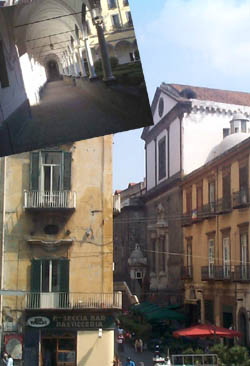 The
original monastery and home of the Franciscan order that inhabits the
church of Santa Maria La Nova was where the present-day Castel
Nuovo, or Maschio Angioino, stands.
In 1279 the order ceded that property to Charles of Anjou for his new
royal palace and, in return, got the new site for their church. Thus
the name “Nova” (new) for this house of worship with
the elegant Renaissance façade. The original ‘new’
church, then, was built in the late 1200s. That original Angevin building
was removed in 1596 to make way for a new structure planned and built
by Giovan Cola di Franco. It is the church you see today as you start
into the old center of town via a small side-street off of via Monteoliveto
across from the east side of the main post office. The main altar is
from 1633 and was designed by Cosimo Fanzago. The
original monastery and home of the Franciscan order that inhabits the
church of Santa Maria La Nova was where the present-day Castel
Nuovo, or Maschio Angioino, stands.
In 1279 the order ceded that property to Charles of Anjou for his new
royal palace and, in return, got the new site for their church. Thus
the name “Nova” (new) for this house of worship with
the elegant Renaissance façade. The original ‘new’
church, then, was built in the late 1200s. That original Angevin building
was removed in 1596 to make way for a new structure planned and built
by Giovan Cola di Franco. It is the church you see today as you start
into the old center of town via a small side-street off of via Monteoliveto
across from the east side of the main post office. The main altar is
from 1633 and was designed by Cosimo Fanzago.
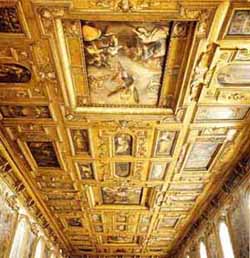 The
most spectacular work of art within the church –indeed, one of
the most spectacular in the entire city-- is the magnificent 46-panel
gilded fresco on the ceiling (photo). The fresco dates back to 1600
and is the collective work of a number of artists, including Luca Giordano.
Various magnifying mirrors are set up at ground level within the church
to enable visitors to view the ceiling more easily. The church, itself,
is an integral part of the whole monastic complex, much of which now
houses municipal office space. The
most spectacular work of art within the church –indeed, one of
the most spectacular in the entire city-- is the magnificent 46-panel
gilded fresco on the ceiling (photo). The fresco dates back to 1600
and is the collective work of a number of artists, including Luca Giordano.
Various magnifying mirrors are set up at ground level within the church
to enable visitors to view the ceiling more easily. The church, itself,
is an integral part of the whole monastic complex, much of which now
houses municipal office space.
Santa Maria
la Nova was closed in 1980 due to damage caused by the earthquake in
that year; it was reopened in 1992 for a few years, at which time visitors
had the opportunity to view the splendid magnificent interior of the
church. It was closed in 1997 for repairs to the building and, in particular,
to restore the ceiling fresco. It will reopen on Jan. 4 with an orchestral
and choir concert that will be taped for later broadcast by the Italian
national television network.
This will
mark the beginning of what everyone hopes will be a prosperous future
for the building and adjacent monastery. The church will no longer be
a house of worship. “There are enough churches in this area to
handle the demand,” says Father Giuseppe Reale of the resident
Franciscan order. Santa Maria La Nova will be transformed into a Center
for Sacred Music; the acoustics are already known to be outstanding,
and the church organs are fine instruments and have been restored. Most
interesting –this is where the “prosperous” part comes
in—is the plan to turn part of the monastery, itself, into a four-star
hotel! This will be the second such Franciscan venture into the hotel
business in Naples. The San Francesco del Monte hotel on the Corso Vittorio
Emanuele, overlooking the whole city of Naples and with a direct view
of Mt. Vesuvius and the Sorrentine peninsula, has been open for a few
months and seems to be doing well. The Santa Maria La Nova hotel with
“monastic style” furnishings (for those who wish to engage
in some 4-star meditation) with easy access to the auditorium of the
Center for Sacred Music) should be open in 2003.
(The hotel
business is another episode in the collective—but diverse—destinies
of the ex-monasteries of Naples. See here.)
Archaeology (2)—
From the
entry on "Geology of the Bay of Naples" (click here for the entire article):
| Interestingly
and very recently (late 2001), archaeology around Vesuvius near
the town of Nola has shed light on the fate of a so-called “Bronze
Age Pompeii”. In about 1800 b.c. —roughly
about the same time as Hammurabi was formulating his exemplary
Code in far-off Babylon—a little village on the slopes
of the volcano was buried by an eruption. The site is already
recognized as one of the world's best-preserved prehistoric
villages, found only because someone decided to build a supermarket
with an underground parking structure. Thus far, no human remains
have been uncovered, indicating that the inhabitants had enough
time to avoid the fate of the some 2,000 victims of the Pompeii
eruption. |
That is
still making news. The papers yesterday carried an item on the archaeological
dig in Nola, where yet another 4,000-year old structure has been been
uncovered—a 50-foot-long structure containing some vases and cooking
utensils. It was possibly a communal gathering place for villagers.
Archaeologists have by now determined that this "Bronze Age Pompeii"
was large enough to have buildings laid out in groups—not necessarily
blocks, but at least according to some plan that indicates significant
social structure. Giuseppe Vecchio, the archaeologist in charge of the
site, also adds, "Where there is a village, there has to be a cemetery,
a necropolis, and we'll find that sooner or later." That would be a
significant find. There is apparently a lot more to be uncovered in
the area. Much of what has already been brought to light is now protected
by modern metal and plastic coverings—good, perhaps, but maybe
not as good as the lava that has served quite well for four millennia.
Fireworks
 In
Naples, some firecrackers have innocent enough sounding names—“Minerva,”
for example. Others—perhaps in the quest for nomenclature that
will attract the young male—try names such as “Maradona,”
after the great Argentine soccer star who played for Naples for many
years. Then there are the ominous ones—last year, one bore the
moniker, “Big Brother” (certainly more for the popular TV
show of that name than as a nod to George Orwell) and another, “Osama
Bin Laden”. The fact that that one sold well was less of an ideological
statement than a tribute to its being everything a juvenile fireworks
nut could ask for —loud, highly explosive, and very dangerous. In
Naples, some firecrackers have innocent enough sounding names—“Minerva,”
for example. Others—perhaps in the quest for nomenclature that
will attract the young male—try names such as “Maradona,”
after the great Argentine soccer star who played for Naples for many
years. Then there are the ominous ones—last year, one bore the
moniker, “Big Brother” (certainly more for the popular TV
show of that name than as a nod to George Orwell) and another, “Osama
Bin Laden”. The fact that that one sold well was less of an ideological
statement than a tribute to its being everything a juvenile fireworks
nut could ask for —loud, highly explosive, and very dangerous.
Every year
at this time in Naples, a general cautionary alarm goes out to the public:
Don’t use illegal fireworks this New Year’s. And every year,
Naples seems to lead Italy in the race to see how many people are injured—or
killed—by shoddily homemade firecrackers. Calling them “crackers,”
of course, is dishonest; they don’t “crack”, they
blow up—sometimes in the hands of a kid who placed a bit too much
confidence in a fuse that was supposed to give him 10 seconds to get
away—at least that’s what the dealer told him.
Neapolitan
fireworks from 1819
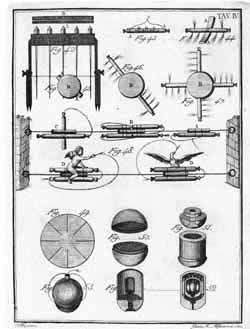 The Italian
Environmental League reports that in the last two New Year’s celebrations
in Naples, 4 have died and 275 have been injured; 30 have been arrested
and 40 tons of illegal fireworks confiscated. Yet, starting a few days
ago, the illegal streetside stands that sell these things have cropped
up in the usual places; the Sanità, the Forcella,
and the Mercato Pendino sections of town. It is no problem all
to pick up the high-powered wherewithal that will let you give the New
Year a hand—finger by finger. The Italian
Environmental League reports that in the last two New Year’s celebrations
in Naples, 4 have died and 275 have been injured; 30 have been arrested
and 40 tons of illegal fireworks confiscated. Yet, starting a few days
ago, the illegal streetside stands that sell these things have cropped
up in the usual places; the Sanità, the Forcella,
and the Mercato Pendino sections of town. It is no problem all
to pick up the high-powered wherewithal that will let you give the New
Year a hand—finger by finger.
There are
36 legitimate manufacturers of fireworks in and around Naples, and this
is the time of year that counts for them. Some of them, too, have had
trouble with the authorities for selling prohibited fireworks—meaning,
too explosive. They have other problems, as well: Yesterday in Orta
di Atella near Caserta a ferocious explosion shook the night when a
car packed with fireworks exploded, leaving shredded metal and charred
body parts over hundreds of square yards. The three victims were thieves
who had just broken into a lightly—or non-guarded legal fireworks
factory and made off with their haul. Maybe one of them lit up a cigarette
as they sped away; maybe one of them slid across the seat too fast and
set off a slight discharge of static electricity. Who knows.
Indeed,
if you live near someone who makes this stuff and stores it at home
all year, waiting for New Year’s, you may never know about it
until a house down the street explodes. Or if you live upstairs from
that person, you may simply never know about it. Never.
Befana,
Christmas (5), Epiphany
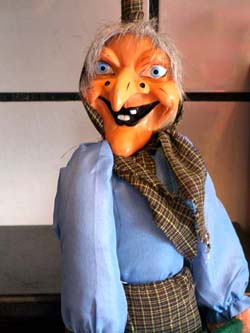 This
morning I noticed in the small coffee bar near my house that what I
would have always considered “Christmas stockings” have
just been put up as decorations. Then, I remembered that in these parts—indeed,
in most of Italy—gift-giving time is far from over. This
morning I noticed in the small coffee bar near my house that what I
would have always considered “Christmas stockings” have
just been put up as decorations. Then, I remembered that in these parts—indeed,
in most of Italy—gift-giving time is far from over.
Long before
Santa Claus, reindeer, fir trees, and snow started showing up on the
unlikely slopes of Vesuvius, the traditional bringer of holiday gifts
was the Befana, an old woman who brings gifts to good children
(or lumps of coal to bad ones) on the evening before Epiphany, January
6. "Epiphany" is from Greek and it means “to manifest” or
“to show”. January 6 is the twelfth day after Christmas
(I think that is the one with Pipers Piping or Drummers Drumming, but
I don’t really remember) and is the day on which Christians commemorate
the manifestation of Christ, the Savior. It is when the Magi appeared
and brought gifts. Depending on the legend, an old woman —either
searching for her child (one of the “first–born” murdered
by Herod) or having been invited to accompany the Magi—also appeared.
Her name, in Italian—Befana—is a corruption of the
word “Epiphany”.
Without
question, there is something much more peaceful and spiritual about
January 6 than December 25. That is, no doubt, due to the commercial
glitter of modern Christmas celebrations. At least in Naples, there
is no such pitch as “only 15 more shopping days till Befana”.
Not yet, anyway. So, the little stockings go up for the gifts, and the
children wait.
And this
from Richard Crashaw (1612–1649):
“May
the great time in you still greater be, while all the year is your Epiphany.”
Metropolitana
(3)
 Naples
certainly doesn’t lack ambitious engineering plans. The decades-long
(and still going on) new metropolitana—subway—is
the classic case. Little by little, that is winding its way towards
completion, and the sections that are already in service have made getting
around the city much easier. Naples
certainly doesn’t lack ambitious engineering plans. The decades-long
(and still going on) new metropolitana—subway—is
the classic case. Little by little, that is winding its way towards
completion, and the sections that are already in service have made getting
around the city much easier.
Getting
into and out of the city is another problem. There are two secondary
narrow–gauge railway lines that serve the city. One is called
the Circumvesuviana; it starts near the central train station
and has an extensive network of stations and track to the west through
the communities on the slopes of Vesuvius—the most densely populated
area in Europe—and on out to the Sorrentine peninsula. The other
one is called the Circumflegrea—also known as the Cumana;
it, too, starts in the center of town and, as the name suggests, goes
west to serve the outlying areas in the Campi Flegrei and beyond, all
the way to end of the Gulf of Naples, itself, near Cuma.
The latest
big engineering plan involves the Cumana. As it stands now, in order
to get to the first station, Soccavo, outside the city to the west,
the Cumana goes through a long (2 miles) and very deep tunnel that bores
beneath the entire hill of Naples that the “Vomero” section
of the city rests on. Many decades ago, the Vomero was remote enough
to be a vacation spot for the well–heeled; to rest up a bit in
the “countryside,” you went up to Vomero. Now, of course,
that part of town is as busy and congested as anywhere else in the metropolitan
area; indeed, the new subway line was started in order to connect Vomero
with the main downtown area.
The plan
in question calls for putting in another station on the Cumana line
between the downtown end–of–the-line and what is now the
first stop, Soccavo. That station will lie directly below the massive
Vomero hill. Then they will sink a passenger elevator from the center
of Vomero 100 meters down through the hill to the new station. It will
be—claims the report in the paper—the deepest subway station
in the world. The plan calls for connecting—by conveyor walkways
for passengers—the new station with the nearby Cilea station of
the new metropolitana. The theory, then, is that with a single change
at that juncture, you will be able to start your trip anywhere out to
the west of the city and wind up on the new subway line with its 20–some
stations.
All this
ambition sounds like a script for Invasion of the Mole People,
and I am reminded of the Spanish move in the 17th–century to prohibit
anymore digging, quarrying, and burrowing beneath the city out of fear
of cave–ins, which were, even then, a problem. Engineers, of course,
tell us that modern methods and materials of construction will actually
make the subsoil safer.
Geology
(1); Stromboli; volcanoes (1)
This
sign warns visitors to the island of the dangers of the active volcano.
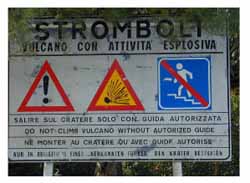 The
papers this morning lead with news of pre–New Year’s fireworks
of an unexpected kind: the volcano on the island of Stromboli erupted
yesterday, dislodging a considerable piece of mountain into the sea.
That, in turn, caused a 60-foot wall of seawater to backwash onto the
island, flooding homes, destroying boats and small harbor facilities,
but injuring only 3 persons. There were no deaths. The
papers this morning lead with news of pre–New Year’s fireworks
of an unexpected kind: the volcano on the island of Stromboli erupted
yesterday, dislodging a considerable piece of mountain into the sea.
That, in turn, caused a 60-foot wall of seawater to backwash onto the
island, flooding homes, destroying boats and small harbor facilities,
but injuring only 3 persons. There were no deaths.
Stromboli
is the northernmost of the Aeolian Islands, a group of some seven islands
north of Sicily. Some of the other islands also have active volcanoes,
including the appropriately named isle of Vulcano. The volcano on Stromboli
is nicknamed, simply, Iddu—Him—by residents of the
island and last erupted 17 years ago. The wave that rose and struck
part of the island as a result of yesterday’s eruption and landslide
at first was called a tsunami. Geologists were quick to point
out this morning, however—for those interested in the fine points
of describing that wall of water about to wash them out to sea—that,
technically, a tsunami is a wave generated by submarine earthquakes
or volcanic eruptions. This was just a lot of water.
The Aeolians
are tightly grouped, and the eruption provided a spectacular show for
the residents of the next island to the south, Panarea. The islands
are a popular tourist target for Neapolitans; the faster hydrofoils
make the run from Naples in about 3 hours. Tourists are now, of course,
on the way off the islands until such time as things get back
to normal, whatever “normal” might mean in a place where
an island is named Vulcano.
Mt. Etna,
of course, right next door on the island of Sicily has been dominating
their news recently. It is currently erupting in its usual slow and
effusive fashion—nothing devastating, just layering up more and
more lava to mark the passage of the millennia, the way some volcanoes
do. Vesuvius—with its own nickname of ‘a muntagna (the
mountain)—here in Naples bides its time. That comes up frequently
in casual conversation—perhaps less casual today.
[There
is relevant information in the entry on The
Geology of the Bay of Naples .]
|
